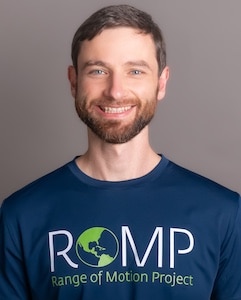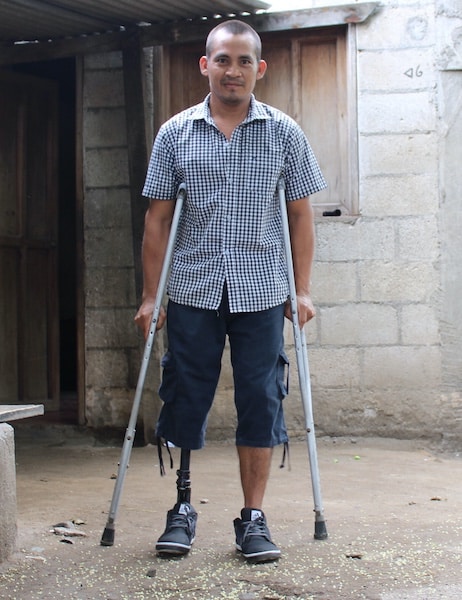Immobility no more

A Waterloo High School graduate has been busy with work in Central and South America for the past decade, pushing to improve care for patients with amputations and now overseeing an organization set to further this goal for groups around the world.
Though he hasn’t made his way to his hometown for some time, Jonathan Naber still feels a strong connection to Waterloo.
A 2007 WHS graduate, he was inducted into the school’s Legacy Society back in 2018 and looks back on his time in the community fondly thanks to the lessons learned here.
“I had, I think, a very positive and really formative experience in Waterloo growing up, kinda both leading up to high school and then during high school,” Naber said. “I think being part of the Waterloo community kind of instilled a lot of the values that I’ve carried with me to this day.”
After graduating, Naber attended the University of Illinois Urbana-Champaign to study engineering.
Naber recalled how his higher education nudged him toward helping others, using his knowledge and skill set to work toward “a much more equal world in which everyone has access to the very best technology.”
The particular niche he found himself in was prosthetic product development.
Naber’s career really began in Guatemala, where he stayed for a year and a half as he worked in a collaborative role with the Range of Motion Project, a nonprofit seeking to ensure access to high-quality prosthetic care for those who have undergone amputation.
His work with ROMP changed his trajectory more than a little, as he became more focused on the public health side of his work rather than purely focusing on technology.
With that change in perspective, Naber then traveled to London to pursue a Master’s of Public Health, further broadening his perspective as he met folks from around the globe.
He honed his focus on the specific concept of community-based rehabilitation, which has been at the center of his work ever since.
“It’s the idea that was originally conceived by the World Health Organization of not simply providing somebody with assistive technology and then never seeing them again but instead actually really accompanying them on a community level and really supporting their full range of needs, not just their assistive technology needs but their full range of needs,” Naber said.
Naber returned to Guatemala after his studies in the United Kingdom, working for the Guatemala National Disability Survey – a short-term project in collaboration with the government to gauge how prevalent disability was throughout the country.
Naber then properly began his career with ROMP in 2017, invited by the founder to bring the community-based rehabilitation model into their efforts.
For a little over eight years, Naber served as chief program officer for ROMP, running programs in Guatemala and Ecuador.
Just a few months ago, Naber saw his title change as he stepped up as ROMP’s executive director.
Providing a further overview on the organization he now leads, he explained ROMP began 20 years ago, focusing its efforts on underserved patients from two particular countries.
“Our mission is to ensure access to high-quality prosthetic care for underserved people, improving their mobility and independence,” Naber said. “Specifically what we do is we operate the largest prosthetic rehabilitation programs in the countries of Guatemala and Ecuador.”
In their work, ROMP offers permanent clinics in each country’s biggest city, offering prosthetic and psychological care, therapy and a full range of service regarding assistive technology.
ROMP also conducts mobile clinics in both countries, traveling to more remote places for stretches of time to meet with and care for patients who would otherwise be unable to get care from them.
The organization makes every effort to provide comprehensive prosthetic care. Reiterating the concept of community-based rehabilitation, Naber said ROMP seeks to provide the necessary technology and work with patients before and after they receive their prosthetic to ensure they are able to use it effectively to better their quality of life.
He further expounded on the idea, recalling how he started at ROMP seeing patients provided with world-class prostheses – the sort of equipment that might cost $50,000 in the United States – who would go home without the proper preparation or follow-up only to discard the technology because they weren’t able to adjust to it or get the best use out of it.
Naber lamented how much of a waste this can be and how it can deprive others of the care they might need.
He further spoke about how negative it is for the person with the prosthetic that they’re unable to use effectively. Such a person’s life, he described, can often consist of just shifting from a bed to a chair, unable to work or enjoy life due to the loss of a limb.
Thus, the community-based rehabilitation model seeks to ensure adequate preparation and follow-up so ROMP resources can be used effectively and patients can experience the positive change they really need.
Naber said the pilot program for this sort of care began with eight patients. That number has since ballooned to 175 patients at a time.
The program finely-tuned at this point, ROMP’s efforts have turned more toward strategy, with Naber beginning his tenure as executive director with a campaign for sweeping change.
“My focus is really… on a global level, really trying to pull more resources together toward what is our fight to make immobility a thing of the past,” Naber said.
This particular effort to make immobility a bygone problem will involve ROMP both honing its own efforts and working with other nonprofits around the world to share their ideas.
Naber noted how ROMP’s waiting list for patients hangs around 750-1,000 individuals.
“That is just an almost unthinkable number of patients to have waiting for care,” Naber said. “Our, immobility is history, campaign is about the new strategy that we’re gonna pursue in the next three years to help us meet the demand for care in Guatemala in Ecuador and to share our model that we’ve developed over these years with the rest of the world.”
The campaign centers around four goals: meeting the demand for care in Guatemala and Ecuador, sharing the ROMP model with the rest of the world, increasing component recycling by clinics in the United States and increasing the financial resources in every ROMP country to achieve financial sustainability.
Naber expanded on these points, particularly clarifying how ROMP sources its prosthetics.
As he explained, the organization relies on a tremendous network of clinics in the U.S. who provide new or gently used prosthetics that are no longer billed for. Those items are sent to ROMP’s U.S. headquarters in Denver, Colo., where they are exported on a daily basis.
The vast majority of prosthetics used by ROMP are recycled in this way. Naber noted, however, the sockets for these pieces are always custom, with patients undergoing a casting and molding process of their remaining limb after they’ve been assessed by ROMP clinicians.
When it comes to spreading the program and ideas used by ROMP for their effective service, Naber pointed to ROMP’s 20 years of effort in honing an approach to prosthetic care.
By sharing this approach, as well as an app meant to further streamline other organizations’ abilities to provide care, ROMP hopes to make groups around the world as efficient as they have come to be.
“Every single country, there are organizations that are working to do this thing, and most of them do not have the tools that they need in order to provide the very best care to their patients in order to mobilize their patients as effectively as possible,” Naber said. “ROMP has those tools, and we see a huge opportunity to share those tools with other people.”
Another key goal of the campaign concerns funding and financial sustainability. Naber noted how this part of the campaign has him working toward awareness of ROMP and their goals.
With the campaign launching in October, ROMP is pushing an end-of-year funding effort through December, with 2026 serving as the backdrop for a renewed funding effort as ROMP seeks to raise about $1 million through the year.
He discussed how folks can help with the campaign, donating directly on the ROMP website, becoming members to contribute regular donations, helping to recycle components or simply helping to spread the word on social media.
Concerning ROMP’s goal of making immobility a thing of the past, Naber suggested a change in perspective. He pointed to other matters of public health that were once considered revolutionary or controversial that have since become mainstream and unremarkable.
“We take it for granted today in 2025 that anaesthesia is used in surgery,” Naber said. “I have a 2-year-old son. I take it for granted that the physicians washed their hands before my wife gave birth. These are, for us today in 2025, no-brainer ‘we take them for granted’ things. But 150 years ago, when these things made their debut in the medical world, they were not taken for granted.”
The goal of ROMP, he said, is to make immobility exactly the same, something folks look back on in years to come and wonder how it was ever a concern.
For more information on the Range of Motion Project, visit rompglobal.org.







